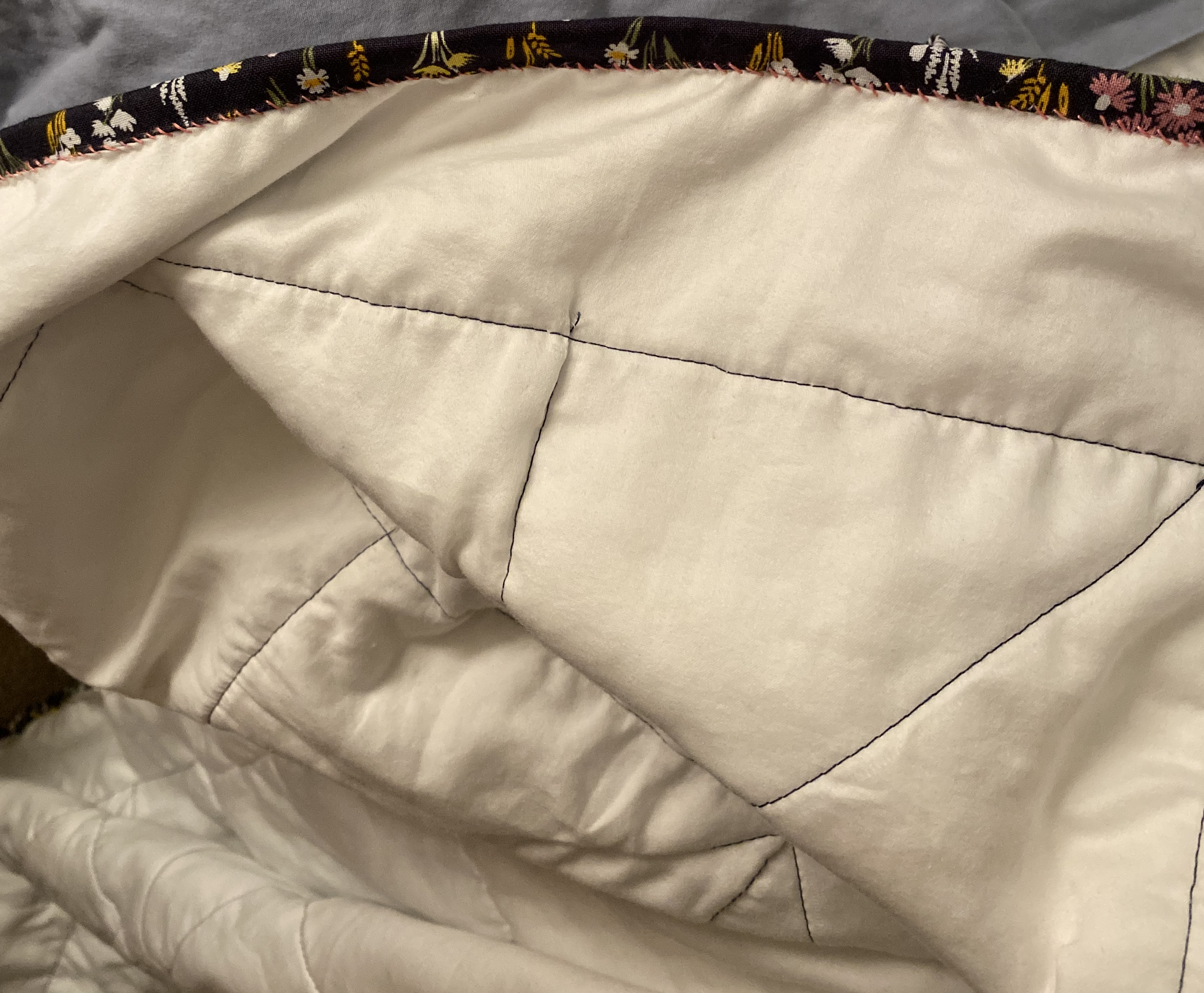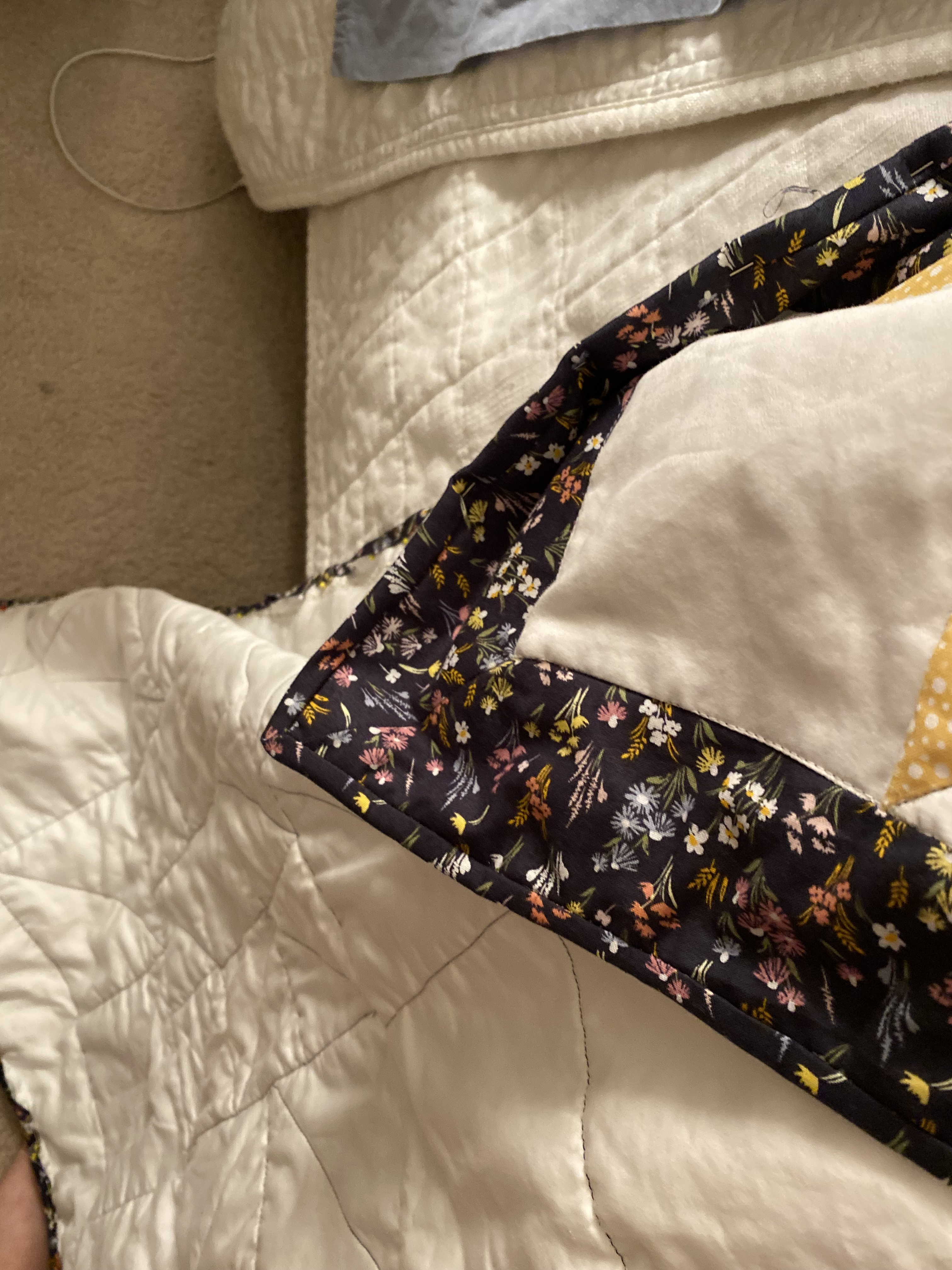Wayfinding Quilt
5/2022
︎ Fiber construction
︎ Quilt math
The women who raised me were always surrounded by textile art. Much of it they made themselves, and the rest of it they traded with one another. My mother’s mother, Nana, taught me how to cross stitch when I was about eight years old, after I asked about her sisters’ cross stitch masterpieces hanging from the walls of my mother’s childhood home in Raleigh. My mother’s father’s mother made quilts “strictly for utility,” but they’re just as beautiful as they are warm.
When I was a child and my family and I traveled to Raleigh, we took the back way—state roads that soared up and through the rolling fabric of the hills of North Carolina’s piedmont. Nana would always point out the painted quilt squares adorning the sides of barns along the road, our favorite one being on a big equipment barn just outside of Asheboro, in Farmer, North Carolina. In these ways I have always been drawn to textile arts—they connect me to the resourceful and clever women from whom I come and their homes. In thinking about how to connect these themes to this project, I thought specifically about family and the sharing of work that Nana did with her sisters. Folk art, to me, shines brightest when its full purpose is able to be realized. This quilt will become a gift for my mother as she prepares to move from my childhood home into a new home of her own design, with shapes that remind me of driving back and forth from her mother’s house along NC 49 through Randolph County, where most of those painted quilt squares still hang.
The construction of this quilt intentionally seeks to echo wayfinding and the countless journeys I made (and continue to make) across the state of North Carolina. The three more complex squares represent the journey itself—up and down NC 49 and US 64 from Charlotte (lower left) to Raleigh (upper right). Charlotte’s square almost looks like a crown, and Raleigh’s square appears almost floral, like a dogwood. The center square’s four prongs represent the cardinal directions, as do each of the 2x2 patches. In addition, the layout of the quilt’s five star squares are laid out similarly to how the five public use squares are laid out in downtown Raleigh, an homage to hte city in which I find so much of my own family history. In an homage to my grandmother, I added some cross-stitch/needlepoint details to these 2x2 patches with reference to travel, directions, and North Carolina.
Family lineage is almost always traced through its fathers. I was incredibly thankful to be able to focus on the lineage of the mothers before me. In the construction, I used textiles from my mother’s house (white sheet) along with fabric that she and Nana helped me to pick out. I used thread that my grandmother had in her collection from the 60s–70s.
When I was a child and my family and I traveled to Raleigh, we took the back way—state roads that soared up and through the rolling fabric of the hills of North Carolina’s piedmont. Nana would always point out the painted quilt squares adorning the sides of barns along the road, our favorite one being on a big equipment barn just outside of Asheboro, in Farmer, North Carolina. In these ways I have always been drawn to textile arts—they connect me to the resourceful and clever women from whom I come and their homes. In thinking about how to connect these themes to this project, I thought specifically about family and the sharing of work that Nana did with her sisters. Folk art, to me, shines brightest when its full purpose is able to be realized. This quilt will become a gift for my mother as she prepares to move from my childhood home into a new home of her own design, with shapes that remind me of driving back and forth from her mother’s house along NC 49 through Randolph County, where most of those painted quilt squares still hang.
The construction of this quilt intentionally seeks to echo wayfinding and the countless journeys I made (and continue to make) across the state of North Carolina. The three more complex squares represent the journey itself—up and down NC 49 and US 64 from Charlotte (lower left) to Raleigh (upper right). Charlotte’s square almost looks like a crown, and Raleigh’s square appears almost floral, like a dogwood. The center square’s four prongs represent the cardinal directions, as do each of the 2x2 patches. In addition, the layout of the quilt’s five star squares are laid out similarly to how the five public use squares are laid out in downtown Raleigh, an homage to hte city in which I find so much of my own family history. In an homage to my grandmother, I added some cross-stitch/needlepoint details to these 2x2 patches with reference to travel, directions, and North Carolina.
Family lineage is almost always traced through its fathers. I was incredibly thankful to be able to focus on the lineage of the mothers before me. In the construction, I used textiles from my mother’s house (white sheet) along with fabric that she and Nana helped me to pick out. I used thread that my grandmother had in her collection from the 60s–70s.
I was also able to do 100% of the construction and quilting on a refurbished Singer from the 1940s—the same kind of machine my great grandmother used to make her quilts.







